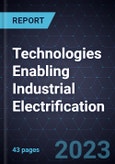Global Efforts to Deliver Net-zero Carbon Emissions Will Spur the Decarbonization and Electrification of Emissions-intensive Industries
The global industrial sector is responsible for nearly 30% of carbon emissions annually. To achieve carbon reduction targets, demand is increasing for the electrification of key manufacturing processes. Focus is currently on achieving direct electrification, which involves replacing fossil fuels used in various industrial processes with technologies that can operate on electricity. With rising renewable energy share in national grids, direct electrification is set to offer significant carbon reduction potential.
In addition to reducing the industrial carbon footprint, electrification is likely to play a main role in reducing reliance on price-volatile fossil fuels, bringing down long-term production costs as renewable energy gets cheaper and supports automation and energy optimization efforts in manufacturing centers.
Global efforts to reach the 2050 net-zero carbon emissions targets and to reduce the impact of pollution in industrial centers, as well as consumers’ growing awareness of and demand for sustainable and ethical products, are driving electrification initiatives across the manufacturing sector. Even though challenges remain, such as the reliability of electricity supply and high upfront costs, the global manufacturing ecosystem is set to undergo profound changes as enabling technologies mature and achieve economies of scale.
This research deliverable covers the following topics:
- Direct industrial electrification techs and current trends, including factors driving adoption of these systems across energy-intensive in industries
- Major stakeholders in the industrial electrification technology landscape
- Techno-economic analysis of direct industrial electrification technologies and examples of industrial-scale adoption through case studies
- Patent landscape and growth opportunities pertaining to process heat electrification technologies








